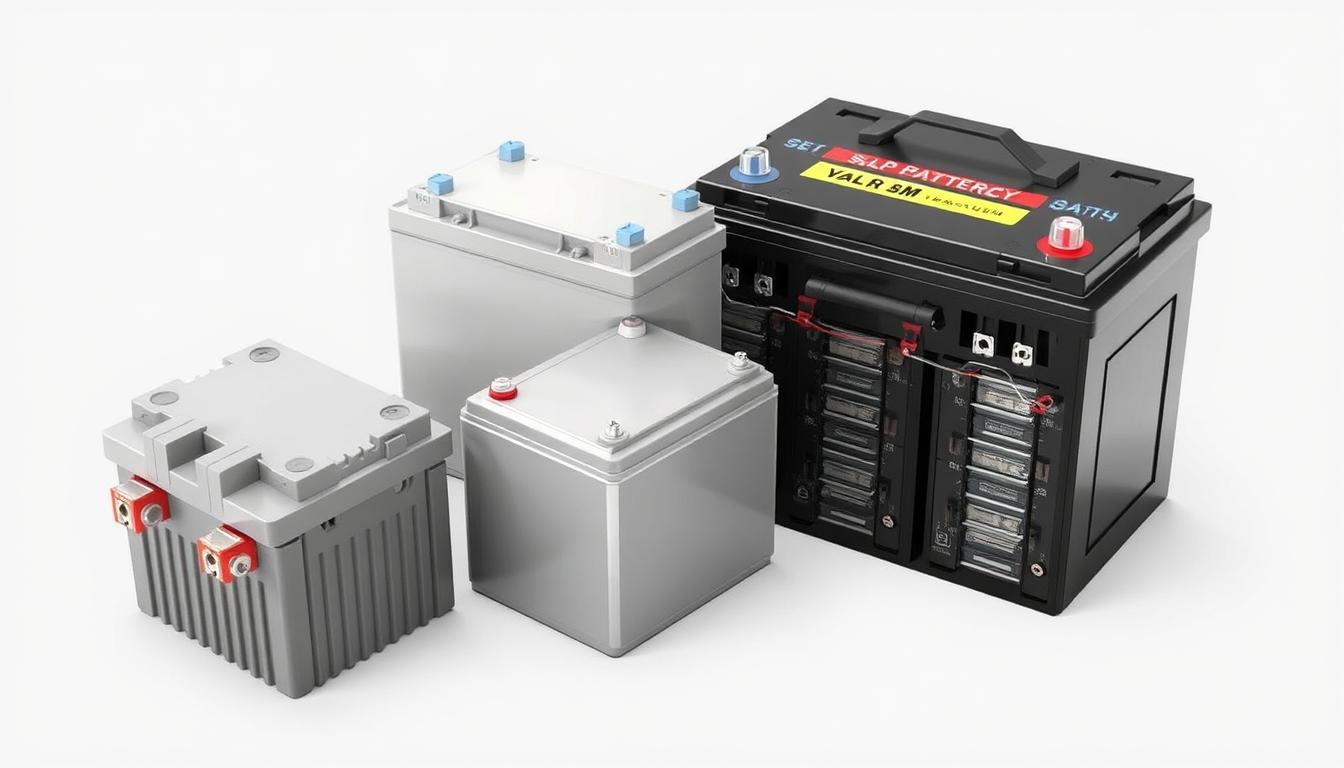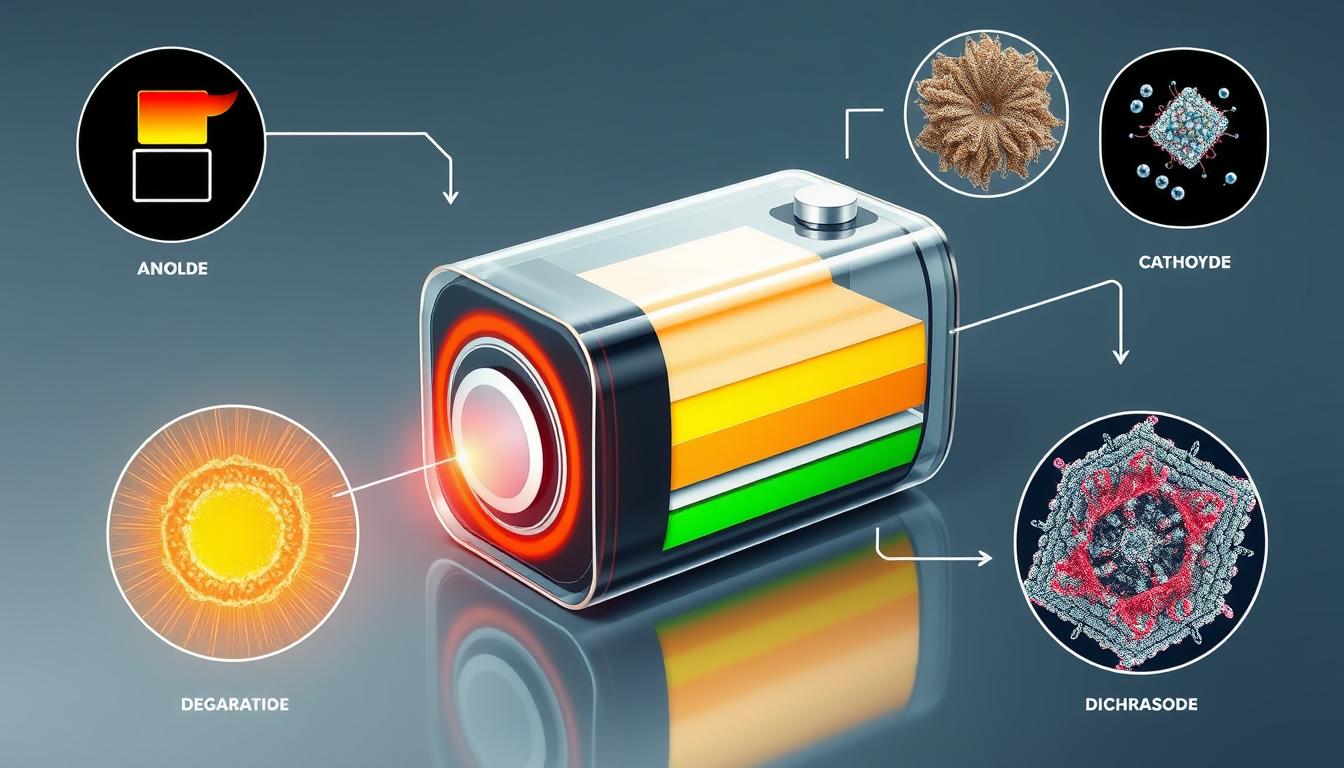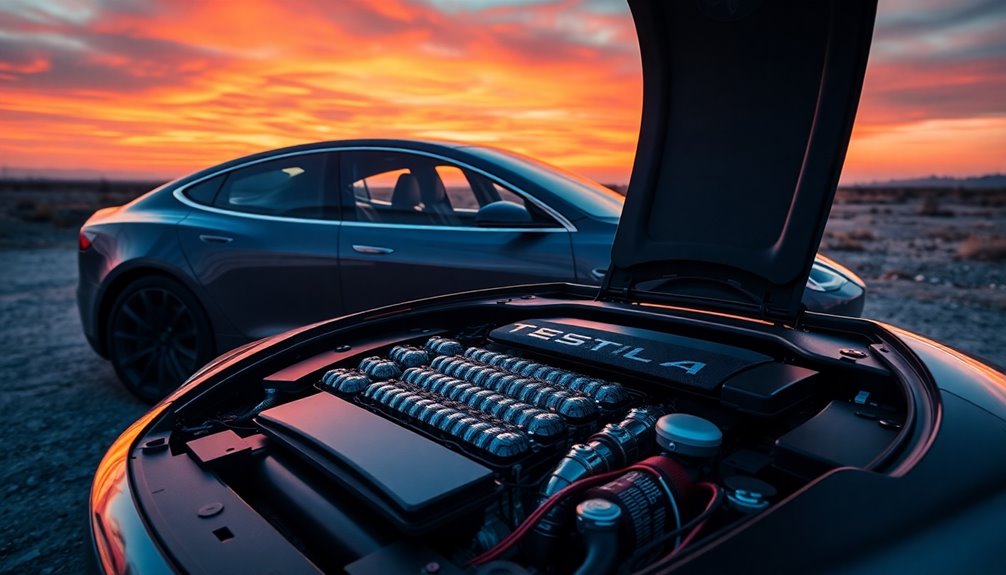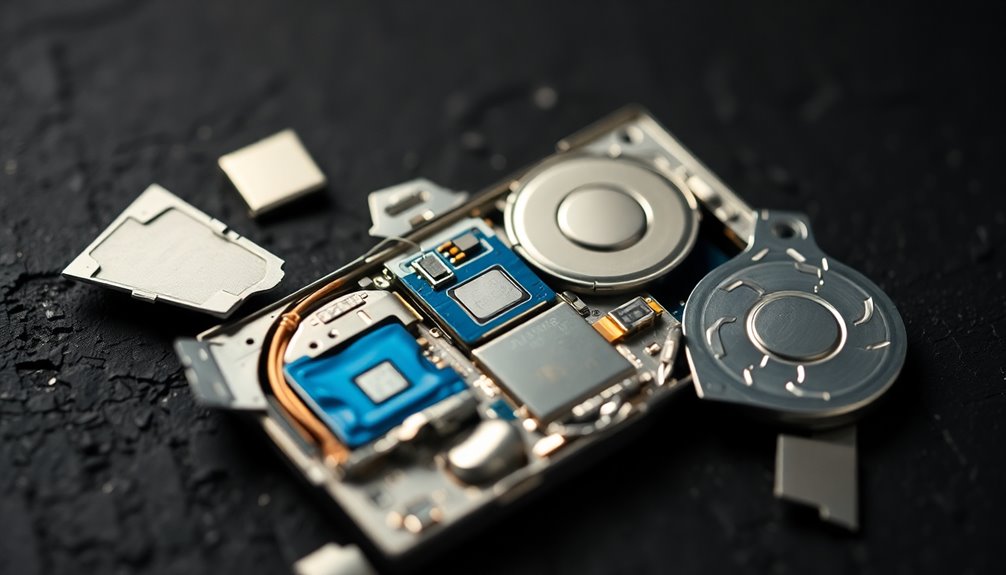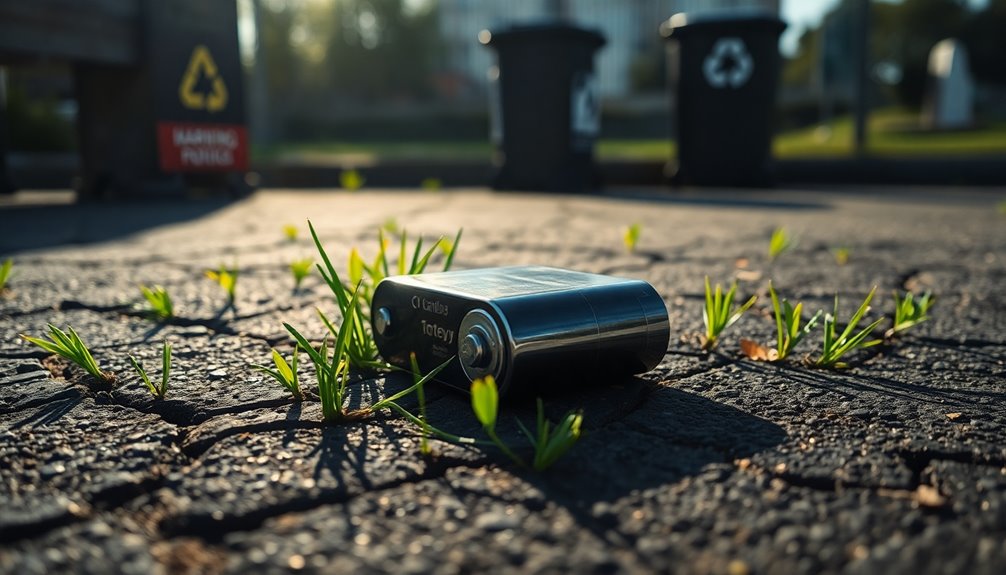Have you ever been left stranded due to a dead battery? This frustrating experience shows the importance of choosing the right battery type. AGM, SLA, and deep cycle batteries each serve specific purposes. Maybe it’s for your recreational vehicle, a backup for your home, or for reliable performance in industrial settings.
By understanding these differences, you can make smart choices. This ensures optimal use and performance1. Let’s dive into the world of batteries and their uses.
Key Takeaways
- Understanding the differences between AGM, SLA, and deep cycle batteries is crucial for optimal performance.
- AGM batteries are often maintenance-free and offer faster recharge rates.
- SLA batteries are versatile and economical for many applications.
- Deep cycle batteries excel in durability and longevity, typically lasting around 2,000 cycles.
- Selecting the right battery type can prevent frustrating failures and enhance your power needs.
Introduction to Battery Types
Choosing the right battery is crucial for different needs, like powering cars or supporting solar systems. A Battery types overview shows the special features of each types of batteries. We’re talking about AGM, SLA, and deep cycle batteries. Each of these is made to perform well in certain situations. Knowing their differences helps in picking the best battery for your needs.
AGM batteries can handle more power without shortening their life, unlike gel and flooded batteries2. They use 100% of their power for charging and using, whereas gel and flooded ones can’t do that as efficiently. Plus, they last longer, which helps save money over time2.
SLA batteries are dependable if you need power without interruption, but they do need regular upkeep. They can last from 6 to 48 months, yet only a few make it to 48 months3. Gel batteries are good in the heat but can fail if charged wrong3.
Deep cycle batteries are great for long-term use, like in golf carts, RVs, and solar setups4. It’s best not to use more than 55% of their power to keep them going strong4. Each type of battery has its role, so understanding what they offer is key to making the right choice.
What are AGM Batteries?
AGM (Absorbent Glass Mat) batteries bring a new level of performance, safety, and ease of use. They use a fiberglass mat to hold the electrolyte in place. This design stops leaks and makes them simple to look after. AGM batteries are safe and reliable, perfect for different weather5.
Construction and Design of AGM Batteries
Since the 1970s, AGM battery technology has come a long way. They charge quickly and work well under heavy use compared to other types. Plus, AGM batteries are more affordable than GEL batteries, offering great value for various needs6.
Advantages of AGM Batteries
AGM batteries stand out for their quick charging and high discharge rates. They handle vibrations well, making them great for use in RVs and boats. They last longer and don’t lose charge quickly when not in use, making them ideal for many situations5.
Common Applications of AGM Batteries
AGM batteries are valued for their reliability and don’t require much upkeep. They’re used in:
- Recreational Vehicles (RVs)
- Boats
- Power sports equipment
- Telecommunication systems
- Backup power solutions
AGM batteries are liked for their toughness, safety, and good pricing6.

Understanding SLA Batteries
SLA batteries, or Sealed Lead Acid batteries, play a vital role in many fields. They are built to be safe and easy to use, with a sealed design to stop leaks and reduce upkeep. Their sturdy construction ensures they work safely in diverse settings.
Features of SLA Batteries
One key feature of SLA batteries is that they don’t need water added, making them maintenance-free. They lose charge slower, so they stay charged longer. This makes them trustworthy for emergency backup power.
Benefits of Using SLA Batteries
Using SLA batteries brings many plusses. These batteries are safe in tight spaces due to their sealed form and can be used in different ways. Plus, they work well in any position and last a long time, so you get a steady supply of power7.
Applications for SLA Batteries
SLA batteries are used in many ways, like in uninterruptible power supplies (UPS). They help keep devices running smoothly, like mobility scooters, alarm systems, and medical devices. Their easy-to-care-for nature and flexibility make SLA batteries a favorite in various fields7.

Exploring Deep Cycle Batteries
Deep cycle batteries have unique features that make them different from regular batteries. They let out power slowly, which is great for many needs where ongoing energy is key. Unlike standard batteries that offer quick energy bursts, deep cycle ones provide steady power for a long time. This difference is clear in many important ways.
Design Differences Compared to Regular Batteries
Deep cycle batteries have thicker lead plates. This design helps get more energy out. Regular batteries give a lot of power quickly but can’t keep this up for long. Deep cycle batteries, on the other hand, are made for longer discharges. This makes them very tough. For example, AGM (Absorbed Glass Mat) batteries can release more power than usual types without big damage. This makes them trustworthy for tough situations8.
Benefits of Deep Cycle Batteries
Deep cycle batteries last longer because they can go through many deep discharges safely. They can be charged up many times with little damage. This feature makes them stand out, especially in places that need lots of recharging, like solar setups and boats8. Also, these batteries have a big reserve capacity. That’s important for devices that need constant energy over time.
Typical Uses for Deep Cycle Batteries
Deep cycle batteries are used a lot in places where steady power is needed. They are key in solar setups, electric vehicles, and RVs to keep things running off the grid9. They also power nav systems, onboard electronics, and important accessories in boats10. Their many uses show how vital it is to choose the right battery for your needs.
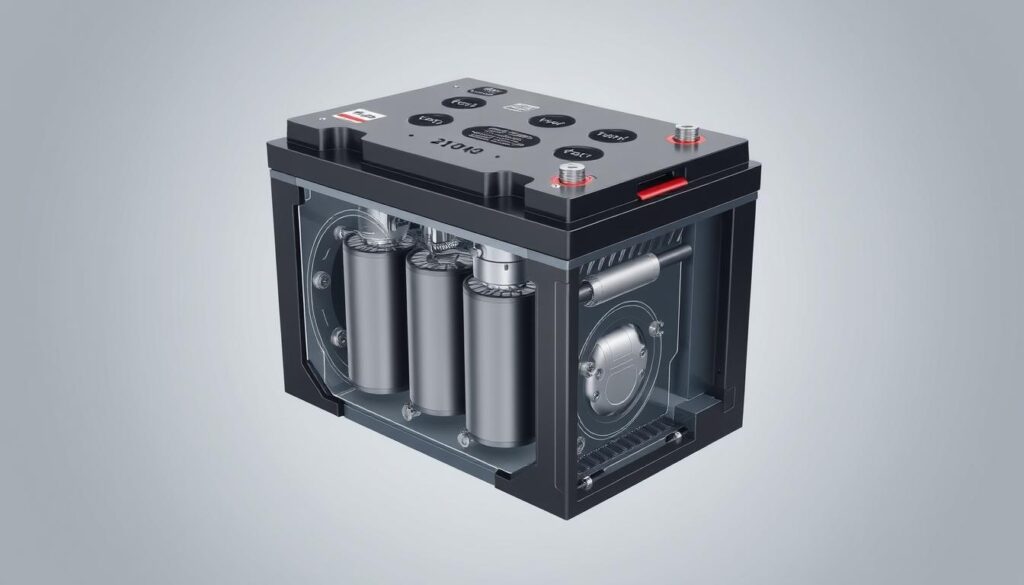
Differences Between AGM, SLA, and Deep Cycle Batteries
To make your battery last longer, it’s important to know how they charge. AGM, SLA, and deep cycle batteries all charge differently. AGM batteries can charge quickly, needing about 14.4 to 15.0 volts11. SLA batteries need a bit less, about 14.2 to 14.7 volts. Deep cycle batteries vary, especially if they are flooded or sealed.
Charging Methods and Requirements
Batteries need specific ways of charging to work best. AGM batteries charge quicker than SLA and deep cycle types. It’s essential to charge AGM batteries right so they work well every day. SLA and deep cycle batteries need extra care to keep them running smoothly.
Maintenance and Durability
How much you need to take care of your battery depends on its type. AGM and SLA batteries are easy because they don’t leak or lose liquid12. But, flooded batteries need you to check their liquid levels often. AGM batteries are really tough, resisting shakes and bumps better than SLA or flooded ones.
Performance Metrics and Lifespan
How long a battery lasts matters a lot. AGM batteries can keep going for 5–7 years, while SLA ones last 3-5 years11. Deep cycle batteries can last for 500 to 1000 cycles, but lithium ones can go over 5000 if used gently. AGM batteries are great for their power and long life, making them a smart choice for many jobs.

Comparing AGM and Flooded Lead-Acid Batteries
Choosing the right battery means knowing how AGM and flooded lead-acid batteries differ. They each offer unique benefits for different needs. This affects where and how you can use them best.
Maintenance Needs
AGM batteries don’t need you to keep an eye on them or add water. Their design uses a glass mat to store the electrolyte, keeping everything in place13. AGM batteries stand out in lead-acid battery tech. They don’t have the spill or plate issues that flooded batteries face14. Flooded batteries, however, need regular care. They want you to check and top up their electrolyte. If you don’t, they won’t work as well because they’re not as robust inside as AGM batteries13.
Cost Considerations
Flooded lead-acid batteries are cheaper at first. Yet, their upkeep might cost you more as time goes by. The starting price is lower, but maintaining them might not be as cost-effective over their life15. AGM batteries are pricier to buy but save money in the long run. They last longer and hardly need any upkeep. This makes them a smarter pick financially, especially if you value durability and performance14.

| Feature | AGM Batteries | Flooded Lead-Acid Batteries |
|---|---|---|
| Maintenance Required | No (maintenance-free) | Yes (requires water addition) |
| Cost | Higher initial cost but lower long-term cost | Lower initial cost but higher maintenance costs |
| Durability | Highly durable with low internal resistance | Less durable, weaker internal design |
| Typical Applications | Standard backup applications | Automotive and low-cost deep cycle units |
Getting to know the maintenance and cost differences can guide you in choosing between AGM and flooded batteries15.
Importance of Battery Selection
Picking the right battery is key to getting the best out of your equipment. The searchstarts with figuring out what your gear needs, through a detailed power needs assessment. This step matches your gear’s needs with the perfect battery type.
Assessing Your Power Needs
There are a few things to think about during this assessment:
- Discharge rates – it’s about knowing how fast you’ll use power, which guides your choice.
- Frequency of use – using something every day might need a different battery than if you hardly use it.
- Maintenance capabilities – some batteries need more care, impacting the costs over time.
Identifying Appropriate Applications
Finding the right fit for a battery is crucial for its performance. For example, AGM batteries are great for high-performance applications, giving reliable power when needed. On the other hand, deep cycle batteries work best for needs that last longer, like in RVs or with renewable energy setups.
Knowing these details greatly improves your chance of picking the best battery. Doing a thorough power needs check and understanding where each battery fits best leads to energy management success.
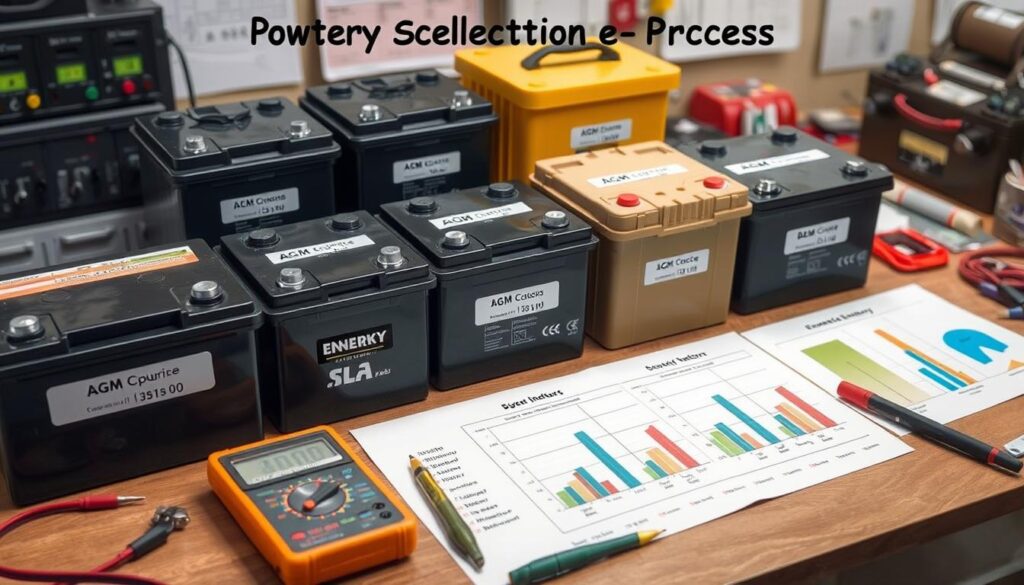
Environmental Impact of Battery Use
Batteries are a big part of our lives and their environmental impact is important. Recycling them is key to lessening toxic waste and saving resources. Batteries like lead-acid and AGM get recycled a lot, at a rate of 99%, which is more than aluminum cans16. But, lithium-ion batteries lag behind with only a 5% recycling rate. This shows we need to do more to recycle these batteries16.
Recycling and Disposal
Recycling batteries right is a must. Many places have laws for recycling lead-acid batteries. For example, Crown Battery makes their batteries with about 80% recycled stuff16. It’s up to us to learn our local rules and use take-back programs. Doing this helps cut down the harm batteries do to the environment.
Choosing Eco-Friendly Options
Going for green batteries helps too. Lithium batteries are better for the planet because they last longer and are less harmful. Look for products that are proven to be sustainable. Companies focusing on clean production make batteries that are better for the earth. It’s crucial we choose these sustainable options16.

Battery Safety Considerations
It’s crucial to ensure safety when installing a battery. Always wear the right protective gear like gloves and goggles. Close attention to battery installation safety guidelines is a must. Be gentle when handling batteries. Some key battery handling tips are:
Installation Safety Tips
- Secure all connections properly to prevent short circuits.
- Utilize insulated tools whenever working with battery terminals.
- Never install a battery in a confined space without ensuring proper ventilation.
- Check for any signs of leaks or corrosion before installation.
Ventilation and Gas Emission Concerns
Ventilation for batteries is very important. Flooded lead-acid batteries release hydrogen gas while charging, which is dangerous. Although AGM and SLA batteries have safety features, they still need good airflow to prevent gas buildup. Knowing about battery gas emissions helps keep everyone safe. Properly disposing of batteries, including recycling, reduces environmental damage. Safe and sustainable battery practices are beneficial for all.

Charging Techniques for Different Battery Types
It’s key to know the right ways to charge your batteries to make them last longer and work better. Different battery types need specific ways to charge for the best performance. This includes how fast to charge them and what kind of chargers to use.
Optimal Charging Rates for AGM and SLA Batteries
AGM batteries charge faster than SLA ones. For AGM batteries, the ideal charge ranges from 14.4 to 15.0 volts during the absorption phase and from 13.2 to 13.6 volts during the float stage. They can charge fully in two to eight hours, depending on their condition and specs17.
On the other hand, SLA batteries do best with an absorption voltage between 14.2 and 14.7 volts and a float voltage from 13.1 to 13.4 volts17. They charge slower to avoid damage and overheating. Keeping the charge under 10 amps is key for their longevity.
Recommended Charging Equipment
Choosing the correct charger is crucial for both AGM and SLA batteries. AGM batteries need special chargers that give less than 14-15 volts to avoid harm. SLA batteries are okay with regular chargers18. Smart chargers are best because they adjust based on the battery’s needs, ensuring the right charging rates for top performance.
| Battery Type | Absorption Voltage Range (V) | Float Voltage Range (V) | Charging Rate (A) |
|---|---|---|---|
| AGM | 14.4 – 15.0 | 13.2 – 13.6 | 10 – 50 |
| SLA | 14.2 – 14.7 | 13.1 – 13.4 | Slow (up to 10) |
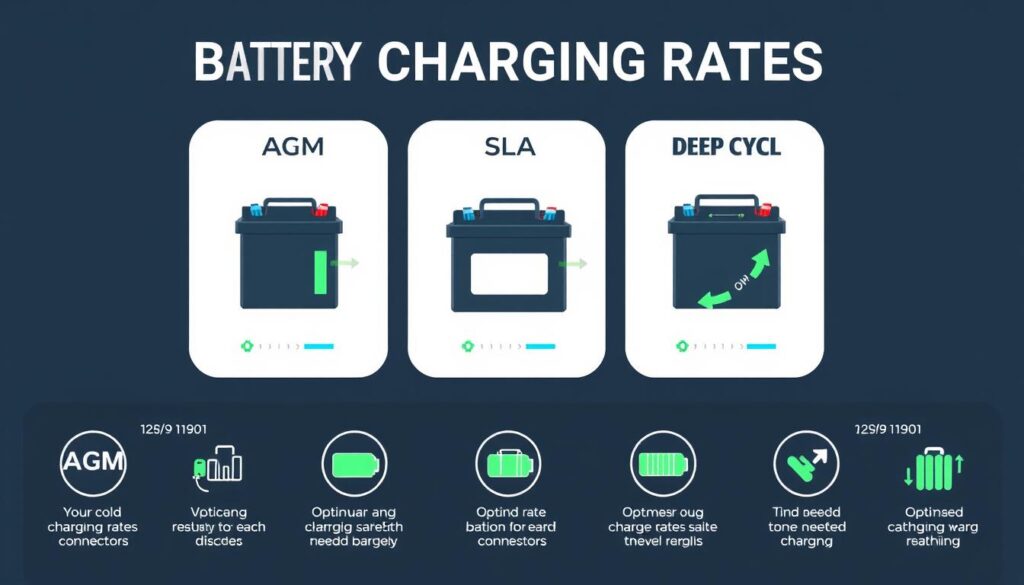
Using the right charging methods and tools will boost your AGM and SLA batteries’ efficiency and life. Knowing how to do this lets you take good care of your batteries. This way, they’ll always meet your power needs1718.
Expert Recommendations for Battery Selection
Choosing the right battery means looking at various factors. You need to think about the cost, how much care it needs, how you will use it, and the environment it will be in. These expert battery tips can really help you pick the best one.
Factors to Consider When Choosing a Battery
When picking a battery, you must look at a few important things:
- Cost: Think about long-term value, not just the initial price.
- Maintenance: Some batteries need more upkeep than others.
- Usage Patterns: Figure out how often and for what you’ll use the battery.
- Environmental Conditions: Make sure the battery works well where you need it.
- Warranty and Manufacturer Reliability: A good warranty shows the manufacturer believes in their product.
Common Mistakes in Battery Selection
Try to avoid these common errors when choosing a battery:
- Picking a battery just for its low upfront cost can end up costing you more later on.
- Ignoring what you really need the battery for might lead to picking the wrong one.
- Forgetting to keep up with maintenance can make the battery work poorly.
- Not thinking about where you’ll use the battery can make it fail too soon.
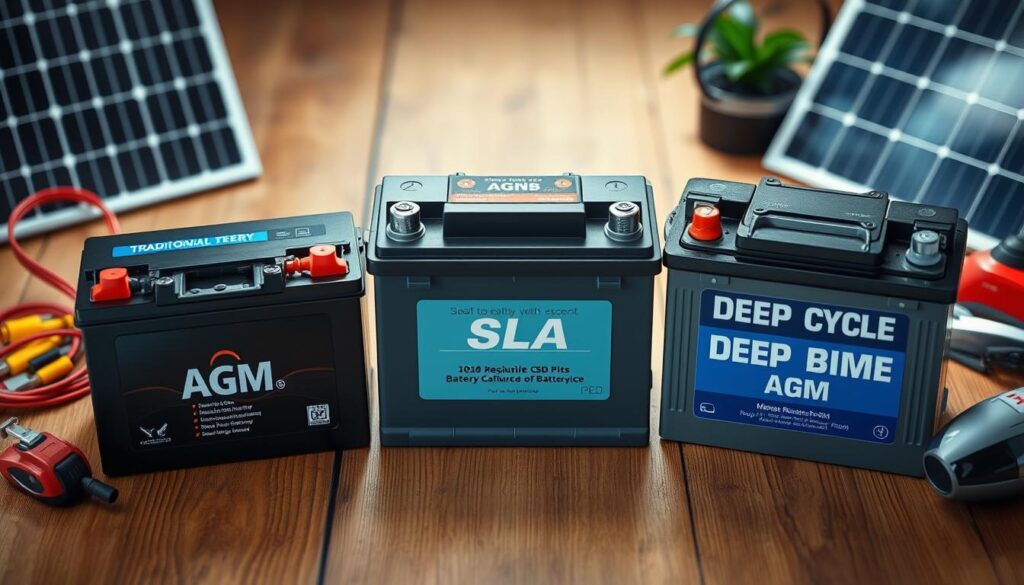
Remembering these points will help you steer clear of bad choices. Using these expert tips ensures you get the most out of your battery. Make smart decisions to sidestep mistakes that could be expensive later on1920.
Conclusion
Picking the right battery type—AGM, SLA, or deep cycle—is key to meet your power needs. Each has unique traits, upkeep needs, and uses to think about. For a quick look at differences, AGMs are tough and charge fast. Yet, deep cycle batteries are great for steady power, using up to 80% of their capacity before needing a charge2122.
The overview on AGM, SLA, and deep cycle batteries shows why knowing their strengths matters. Deep cycle batteries are perfect for many uses like in RVs or solar setups. They give a stable power output. Plus, they last between 3 to 10 years21. This makes them a good choice for long-term energy needs.
Choosing wisely based on your needs leads to the best battery choice. Whether it’s AGM’s fast charging, SLA’s cost-effectiveness, or deep cycle’s steady power, an informed decision boosts performance and lifespan. These are crucial for a successful power setup.
FAQ
What are the key differences between AGM, SLA, and deep cycle batteries?
What are the benefits of using AGM batteries?
Where can I commonly find SLA batteries in use?
What are the advantages of deep cycle batteries?
How do I select the right battery for my needs?
What is the importance of battery maintenance?
How should I recycle or dispose of batteries?
What safety precautions should I take during battery installation?
What charging techniques are best for AGM and SLA batteries?
What are common mistakes made when selecting batteries?
Source Links
- https://www.continentalbattery.com/blog/what-s-the-difference-between-a-deep-cycle-battery-and-a-regular-battery – What’s the Difference Between a Deep Cycle Battery and a Regular Battery? | Continental Battery Systems
- https://batteryguys.com/pages/battery-types-and-comparison?srsltid=AfmBOorNiVGdnGUCOAkiwU5aKX5DdnSHihQ2qbaQt4aefYWcFRpiU6_5 – Battery Types and Comparison
- https://www.batterystuff.com/kb/articles/battery-articles/battery-basics.html?srsltid=AfmBOooFJ43Pz4cARd3iyfrJHqdFZJgOScVVUWhOdbE3cHStRexpyMlp – What is a Battery – A Complete Guide to Battery Basics
- https://www.crownbattery.com/news/deep-cycle-batteries-complete-guide – Deep-Cycle Batteries: A Complete Guide
- https://batteryguy.com/kb/knowledge-base/sealed-lead-acid-sla-absorbent-glass-mat-agm-vs-gel/?srsltid=AfmBOopHgJXDibkuAusvFReqKz7pEPAUl6Ne0P_ldKxogzNPZXYCCKHK – Sealed Lead Acid (SLA) – Absorbent Glass Mat (AGM) vs Gel – BatteryGuy.com Knowledge Base
- https://www.aussiebatteries.com.au/blog/agm-deep-cycle-batteries-vs-gel-deep-cycle-batteries/?srsltid=AfmBOor2EiBvZ4FR2QUCm3NN1bzsbJmq50RCv4rU8N81TtUphBEMiFRW – AGM DEEP CYCLE BATTERIES VS GEL DEEP CYCLE BATTERIES – Gel Vs AGM Which is better AGM or GEL Battery
- https://westinhealthcare.ca/what-is-the-difference-between-agm-and-sla-batteries/ – What is the difference between AGM and SLA Batteries? – Westin Healthcare – Medical Equipment Supplier in Brampton, GTA and Canada
- https://www.energymatters.com.au/deep-cycle-batteries/ – Deep cycle battery guide
- https://www.hzhmarine.com/news/what-is-a-deep-cycle-battery.html – A Comprehensive Guide to Deep Cycle Batteries: Types, Applications, and Maintenance Tips
- https://www.continentalbattery.com/blog/your-ultimate-guide-to-marine-batteries – Your Ultimate Guide to Marine Batteries | Continental Battery Systems
- https://www.batterystuff.com/kb/articles/5-battery-types-explained-sealed-agm-gel.html?srsltid=AfmBOook0aetZjP1FfkQdWoynzp1MIlubJx52XS4lTw2pSKdeDRDcUmH – 5 Battery Types Explained – Flooded, Sealed, AGM, Gel, & Lithium
- https://batteryguy.com/kb/knowledge-base/sealed-lead-acid-sla-absorbent-glass-mat-agm-vs-gel/?srsltid=AfmBOoqM84VKYxct_ZAbpO-kUhYJ_BOwMbwzjcgnj7meu4D2YkU6If_r – Sealed Lead Acid (SLA) – Absorbent Glass Mat (AGM) vs Gel – BatteryGuy.com Knowledge Base
- https://batteryguys.com/pages/the-differences-between-agm-gel-and-flooded-batteries?srsltid=AfmBOooTnvw2VgWKIepC5Qgl_Oz1rBmQmjxJxaY6juv31GqViQ3dyyIO – The Differences Between AGM, GEL and FLOODED Batteries
- https://batteryguy.com/kb/knowledge-base/sealed-lead-acid-sla-absorbent-glass-mat-agm-vs-gel/?srsltid=AfmBOoqPC0Neq5ZlvZqbrX1mr-O_ABYVSJiTOcMGoOIJlRUXqfcrVL4v – Sealed Lead Acid (SLA) – Absorbent Glass Mat (AGM) vs Gel – BatteryGuy.com Knowledge Base
- https://www.batterystuff.com/kb/articles/5-battery-types-explained-sealed-agm-gel.html?srsltid=AfmBOopa5intR3a2mXFqAbTPrcvvEu9S81kOGJQ0fY1PV8yFPOLQTE13 – 5 Battery Types Explained – Flooded, Sealed, AGM, Gel, & Lithium
- https://www.crownbattery.com/news/exploring-the-sustainability-of-lead-acid-and-agm-batteries – Exploring the Sustainability of Lead-Acid and AGM Batteries
- https://www.batterystuff.com/kb/articles/5-battery-types-explained-sealed-agm-gel.html?srsltid=AfmBOooAwR3ZxahrZ1JGRj8cnRcVwshOyhjGgy9g-Gr2sebuqgwlBlyp – 5 Battery Types Explained – Flooded, Sealed, AGM, Gel, & Lithium
- https://www.interstatebatteries.com/blog/how-to-charge-an-agm-battery – Here’s How to Charge an AGM Battery and Why It’s Different
- https://www.batterystuff.com/kb/articles/5-battery-types-explained-sealed-agm-gel.html?srsltid=AfmBOooeWtyzkFCcJ3RiOolpiVAnf5nosei8YiKjGQ66DKz-4EQzPJTd – 5 Battery Types Explained – Flooded, Sealed, AGM, Gel, & Lithium
- https://batteryspecialists.com.au/blogs/news/what-s-the-better-deep-cycle-battery-agm-or-gel?srsltid=AfmBOopAUbmIfsb6ubtWTjvYwyOyzInYMfpn70g20BHwUdpq4CmwSJc4 – What’s the Better Deep Cycle Battery: AGM or Gel?
- https://www.swbatteries.com.au/deep-cycle-battery-everything-you-need-to-know/?srsltid=AfmBOorYK_mU4AqZxbyigYz9VIhy93sE9_n2deq-6thF7kmIki7DGuuE – Deep Cycle Battery, Everything You Need to Know
- https://batteryuniversity.com/article/bu-201a-absorbent-glass-mat-agm – BU-201a: Absorbent Glass Mat (AGM)

